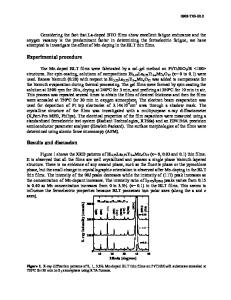Sol-Gel derived Bi 4-x Nd x Ti 3 O 12 Thin Films and Their Characterization
- PDF / 145,573 Bytes
- 6 Pages / 612 x 792 pts (letter) Page_size
- 86 Downloads / 464 Views
F3.35.1
Sol-Gel derived Bi4-xNdxTi3O12 Thin Films and Their Characterization R.E. Melgarejo, M.S. Tomar*, A. Hidalgo, and R.S. Katiyar1, Physics Department, University of Puerto Rico, Mayagüez, PR 00681-9016 *Email: [email protected] 1
Physics Department, University of Puerto Rico, San Juan, PR 00931-3343
ABSTRACT Nd substituted bismuth titanate Bi4-xNdxTi3O12 were synthesized by sol-gel process and thin films were deposited on Pt substrate (Pt/TiO2/SiO2/Si) by spin coating. Thin films, characterized by X-ray diffraction and Raman spectroscopy, shows complete solid solution up to the composition x < 1. Initial results indicate that the ferroelectric polarization increases with increasing Nd content in the film with 2Pr = 50µC/cm2 for x = 0.46, which may have application in non-volatile ferroelectric memory devices. INTRODUCTION Bi4Ti3O12 is one of the few compounds within the Aurivillius family1-3 that has a monoclinic ferroelectric structure, with one component of the polarization in plane of layers, and the other perpendicular to this plane. The origin of ferroelectric polarization within the layers may be4 due to the large displacement of Bi3+ cations in the pervoskite A site with respect to the chain of TiO6 octahedra. The Bi3+ ion in A site is strongly under bonded, and Ti4+ ion in B site is slightly overbonded. Thus, the partial replacement of Bi3+ by suitable trivalent tansistion metal cations, could modify the polarization behavior of the material system. Recent reports of large ferroelectric response5-7 in Bi4-xNdxTi3O12 thin films, has generated a renewed interest in substituted Bi4Ti3O12 materials. Here, we report on the structural properties and ferroelectric polarization achieved in Bi4xNdxTi3O12
thin films prepared by sol-gel process for different compositions.
EXPERIMENT AND RESULTS Bismuth nitrate, neodymium nitrate and titanium isopropoxide were used as the precursors for Bi, Nd and Ti respectively, and acetic acid and methoxyethanol were the solvents. With the proper processing, the films were deposited on a Pt substrate
F3.35.2
(Pt/TiOx/SiO2/Si) by spin coating with 3000 rpm. The films were annealed at 700oC and characterized by X-ray diffraction and Raman spectroscopy. Cu Kα radiation (0.15405 nm) was used for recording x-ray diffraction patterns on Bi4-xNdxTi3O12 materials for different composition using Siemens D5000 x-ray diffractometer. Figure 1 shows the x-ray diffraction patterns 0.45 µm thick film of the
Pt
Thin films on Pt/Si 700°C
(317)
(173)
(2 0 14)
(202) (1 1 15)
(0 0 16)
(0 0 14)
(0 0 12)
(0 0 10)
(008) (111)
(006)
(004)
(117)
Intensity (Arb. Units)
Bi4-xNdxTi3O12
x = 0.46
x = 0.40
x = 0.16
x = 0.00
10
20
30
40
2 θ (Angle Degree)
50
60
Figure 1. X-ray diffraction patterns of Bi4-xNdxTi3O12 films on Pt substrate (Pt/TiOx/SiO2/Si) with x = 0.00, 0.16, 0.40, 0.46, and annealed at 700o C.
Bi4-xNdxTi3O12 films with compositions; x = 0.00, 0.16, 0.40, 0.46. X-ray diffraction patterns show single phase materials of bismuth layered structure showing the pre
Data Loading...










